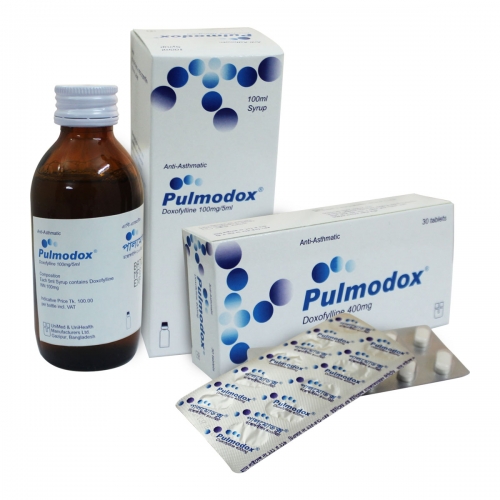ঔষধের বিস্তারিত বা বিকল্প ঔষধ জানতে ঔষধের নাম দিয়ে সার্চ দিন। যেমন- Napa বা Alatrol বা Amodis
Pulmodox 400mg
TabletDoxophylline
Unimed Unihealth MFG. Ltd
Other Strength:
- Pulmodox 200mg
Alternative:
- Fixolin 400mg
- Dophylin 400mg
- Brezofil 400mg
- Flindof™ 400mg
- Clarence 400mg
- Doxofyl 400mg
- Doxofyl SR 400mg
- Doximar 400mg
- Doxolator 400mg
- Docopa 400mg
- Phydox 400mg
- Pulmino 400mg

Pulmodox
Presentation
Pulmodox 200mg tablet: White, oblong-shaped, scored tablet; each tablet contains Doxofylline lNN 200mg.
Pulmodox 400mg tablet: White, oblong-shaped, scored tablet; each tablet contains Doxofylline lNN 400mg.
Pulmodox syrup: Clear, colourless, blueberry-mint flavoured syrup; each 5ml syrup contains Doxofylline lNN 100mg.
Indications
Bronchial asthma.
Chronic Obstructive Pulmonary Disease (COPD).
Pulmonary disease associated with bronchospasm.
Dosage and administration
Pulmodox 200mg tablet- Children aged 6-12 years: 1 tablet one to three times daily.
Pulmodox 400mg tablet- Adults: 1 tablet two to three times daily.
Pulmodox Syrup-Children (above 3 years of age): The recommended dose of Doxofylline is 12mg/kg daily, divided into 2 dose. In case of unsatisfactory response, it can be increased up to 18mg/kg daily.
Contra-indications, warnings, etc.
Contra-indications: Doxofylline is contraindicated in individuals with known hypersensitivity to the drug or other xanthine derivatives. It is also contraindicated in patients with acute myocardial infarction, hypotension and during lactation.
Precaution: Numerous factors may reduce the hepatic clearance of xanthine derivatives with increased plasma levels of the drug. These factors include age, congestive cardiac decompensation, chronic obstructive pulmonary disease, severe liver disease, concomitant infections, the concurrent administration of several drugs such as: erythromycin, TAO, lincomycin, clindamycin, allopurinol, cimetidine, influenza vaccine and propranolol. In these cases, it may prove necessary to reduce the dosage of the drug.
In case of factors that may influence the clearance of xanthine derivatives, monitoring of the concentration of the blood levels of the drug is recommended for the control of the therapeutic range.
Caution should be observed in administering the product to patients with cardiac disease, hypertension, in the elderly, in patients with severe hypoxemia, hyperthyroidism, chronic corpulmonale, congestive heart failure, liver disease, peptic ulcer and in those with renal impairment. In particular, it is to be used with caution in patients with congestive heart failure, since the clearance of the drug is considerably slower in these patients in which high blood levels may persist for long periods even after discontinuation of the treatment. There is no risk of addiction or any other form of dependence.
Drug Interaction: Doxofylline should not be administered with other xanthine preparations. It is recommended to limit consumption of beverages and food containing caffeine. Caution should be exercised in administering Doxofylline together with ephedrine or other sympathomimetic drugs. The concurrent administration of many drugs such as erythromycin, TAO, lincomycin, clindamycin, allopurinol, cimetidine, influenza vaccine and propranolol may reduce the hepatic clearance of xanthine derivatives with an increase in the plasmatic levels of the drug. Phenytoin, other anticonvulsants and cigarette smoking may increase the clearance of xanthine derivatives with a reduction of plasmatic half-life. In these cases, it may prove necessary to increase the dosage of the drug.
Pregnancy and lactation: Animal tests have shown that the active ingredient of Doxofylline does not interfere with pre- and postnatal growth. However, as there is not sufficient clinical evidence about the effects of the drug during pregnancy, use of the drug during pregnancy should be evaluated carefully case by case on the basis of the risk-benefit ratio. The drug is contraindicated during lactation.
Effects on ability to drive and use machines: The product does not affect the patient’s alertness and therefore does not interfere with his/her ability to drive and use machines.
Side-effects: Patients treated with xanthine derivatives may suffer nausea, vomiting, epigastric pain, headache, irritability, insomnia, tachycardia, extrasystoles, tachypnea, and in rare cases, hyperglycemia or albuminuria. In case of overdose severe cardiac arrhythmias and tonic-clonic seizure may occur. These effects may represent the first signs of intoxication. The appearance of side effects may require discontinuation of the treatment which, if necessary, at the physician’s discretion, may be resumed at lower doses after all signs and symptoms of toxicity have subsided.
Overdose: As there is no specific antidote, in case of overdose a symptomatic treatment of cardiovascular collapse should be instituted.
Pharmaceutical precautions
Store in a cool and dry place, protected from light.
Packaging quantities
Pulmodox 200mg tablet: Each box contains 30 tablets in Alu-PVDC blister pack.
Pulmodox 400mg tablet: Each box contains 30 tablets in Alu-PVDC blister pack.
Pulmodox Syrup: Bottle containing 100ml syrup.
এই পাতাটি ১১২ বার দেখা হয়েছে
রাজডক কী?
ফ্রী সদস্য হোন Click Here
ডাক্তার হিসাবে যোগদান করতে Click Here
নার্স / টেকনোলজিস্ট হিসাবে যোগদান করতে Click Here
ফ্রী সদস্য হোন Click Here
ডাক্তার হিসাবে যোগদান করতে Click Here
নার্স / টেকনোলজিস্ট হিসাবে যোগদান করতে Click Here

